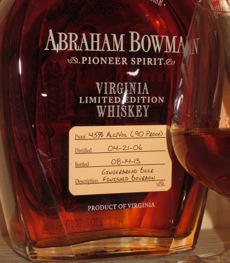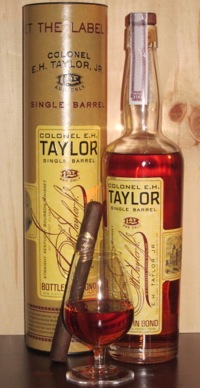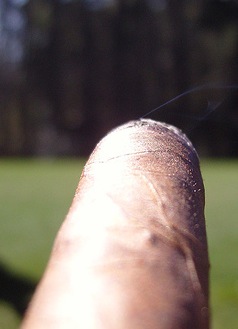I remember having my first pumpkin beer in college, Shipyard Punpkinhead. Back then, it was a Halloween novelty. There weren’t that many and there were only (it seemed) far fewer that could be found at any given beer store.
 Today pumpkin beers have exploded. My local grocery store has half a dozen in stock, and there are no fewer than a few dozen at my local beer and wine shop. Pumpkin pie (which more adequately describes most pumpkin beers than just “pumpkinâ€) is a perfect flavor for beer for autumn nights, when the temperature is crisp and we celebrate Halloween and Thanksgiving.
Today pumpkin beers have exploded. My local grocery store has half a dozen in stock, and there are no fewer than a few dozen at my local beer and wine shop. Pumpkin pie (which more adequately describes most pumpkin beers than just “pumpkinâ€) is a perfect flavor for beer for autumn nights, when the temperature is crisp and we celebrate Halloween and Thanksgiving.
Abraham Bowman Limited Edition Gingerbread Beer Finished Bourbon, however, is the first such attempt I’ve seen to take the concept into bourbon. No, gingerbread and pumpkin aren’t exactly the same thing, but they share many similar characteristics: sweetness, cinnamon spice, nutmeg, and an association with autumn.
Founded in 1935, Bowman is Virginia’s preeminent bourbon distillery. Now based in Fredericksburg, the distillery is owned by Sazerac, which also owns the world-renowned Bufallo Trace Distilery in Kentucky. Reportedly, much (if not all) of what Bowman makes is distilled twice, first at Buffalo Trace before being shipped to Bowman where it is then distilled a second time on-site before being aged in Fredericksburg.
Bowman makes a number of different lines including Virginia Gentleman, Bowman Brothers (small batch, 90-proof), John J. Bowman (single barrel, 100-proof), and Abraham Bowman, which is released in small batches of limited edition whiskey, the latest being its Gingerbread Beer Finished Bourbon.
To make this unique bourbon, Bowman sent used bourbon barrels to the Hardywood Brewery in Richmond, Virginia, where they were used to age the brewery’s Gingerbread Stout. After that the barrels were sent back to Bowman, who used it to finish bourbon that had already been aged for eight years. After three months in the used gingerbread beer barrels, Abraham Bowman Limited Edition Gingerbread Beer Finished Bourbon was bottled at 90-proof.
The result is a bright, copper-colored spirit not dissimilar to the their small batch variety. On the nose you pick up slight hints of the gingerbread beer finish with clove and vanilla.
On the palate, the special finish becomes more apparent. It features a lush mouthfeel with classic vanilla and oak, combined with dashes of nutmeg, bread, and fall spices. The finish is notably short, though the spices linger a bit longer.
I can’t help but wonder if this wouldn’t be even better at a slightly higher proof (100 or even a bit higher?) as it’s a touch thin. Still, it’s an enjoyable spirit that subtlety shows off just enough of its unique finish. It’s perfect for this time of year, though—like pumpkin beer—I’m not sure I’d want to drink it year-round.
I’d recommend a medium-bodied cigar with plenty of Honduran tobacco as a pairing; something that has both spice and balance. Try the Room 101 Namakubi Ecuador, Sencillo Platinum, or Camacho Connecticut.
–Patrick S
photo credit: Stogie Guys




 Between January and May this year (the latest published data), 47 million cigars were imported from the Dominican Republic, while just under 43 million were imported from Nicaragua, less than a 10 percent difference. Last year for the same period the Dominican had imported 44.8 million, versus 36 million from Nicaragua, a 20 percent difference.
Between January and May this year (the latest published data), 47 million cigars were imported from the Dominican Republic, while just under 43 million were imported from Nicaragua, less than a 10 percent difference. Last year for the same period the Dominican had imported 44.8 million, versus 36 million from Nicaragua, a 20 percent difference.
 That’s why I was enthusiastic about trying one of Buffalo Trace’s newer offerings: E.H. Taylor, named after Colonel Edmund Haynes Taylor, Jr., one of the founding fathers of the bourbon industry and one-time owner of what is now called Buffalo Trace Distillery. Taylor was a proponent of the Bottled-in-Bond Act of 1897, which ensured quality standards for “bottled-in-bond” bourbon (back then lots of bourbon was mixed with things like tobacco, turpentine, or other horrible additives to appear more aged than they were). The Act also ensured that the federal government could more easily collect taxes.
That’s why I was enthusiastic about trying one of Buffalo Trace’s newer offerings: E.H. Taylor, named after Colonel Edmund Haynes Taylor, Jr., one of the founding fathers of the bourbon industry and one-time owner of what is now called Buffalo Trace Distillery. Taylor was a proponent of the Bottled-in-Bond Act of 1897, which ensured quality standards for “bottled-in-bond” bourbon (back then lots of bourbon was mixed with things like tobacco, turpentine, or other horrible additives to appear more aged than they were). The Act also ensured that the federal government could more easily collect taxes. There’s obviously a good deal of personal preference when it comes to reviewing cigars, but when reviewers frequently notice the same flavors in the same cigars, it’s evidence that there’s also quite a bit of science to tasting cigars. In my experience, it’s mostly a question of training yourself to observe all the complexities that a cigar can demonstrate. To that end, for those who want to develop their palate and become better at cigar tasting, here are five suggestions:
There’s obviously a good deal of personal preference when it comes to reviewing cigars, but when reviewers frequently notice the same flavors in the same cigars, it’s evidence that there’s also quite a bit of science to tasting cigars. In my experience, it’s mostly a question of training yourself to observe all the complexities that a cigar can demonstrate. To that end, for those who want to develop their palate and become better at cigar tasting, here are five suggestions: Patrick Ashby
Co-Founder & Editor in Chief
Patrick Ashby
Co-Founder & Editor in Chief Patrick Semmens
Co-Founder & Publisher
Patrick Semmens
Co-Founder & Publisher George Edmonson
Tampa Bureau Chief
George Edmonson
Tampa Bureau Chief